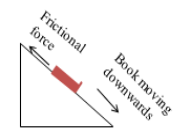NCERT Solutions for Class 8 Science Chapter 9 Friction - Free PDF Download
FAQs on NCERT Solutions for Class 8 Science Chapter 9 Friction
1. Explain the Concept of Sliding Friction and its Relation to the Mechanism of Static Friction.
Frictional forces play a key role when irregularities on the surface of an object are discovered even if the surface is smooth. This is observed when the irregularities of two surfaces come into contact with each other and get interlocked. Sliding friction or kinetic friction is a contact force that resists the sliding motion of two objects. Static friction is the force of friction observed on a stationary object. It is larger than sliding friction as the interlocking mechanism is very small.
2. What are Some Examples of Friction Observed in Our Daily Lives?
Friction is both a friend and a foe. Some instances where we see friction in action are as follows:
Walking or running up or down a hill.
The wear and tear of shoes after vigorous activity.
The contact between the pen and the paper and the motion of the pen while writing.
The damages are caused by continuous exposure to heat in heavy-duty machines as they are continuously run. Therefore, lubricants are used to decrease the wear and tear of these machines.
Rubbing our hands together to generate heat
3. What are the various types of friction? Explain.
There are four types of Friction:
Static Friction - The frictional force, which acts in between two surfaces, when both are at rest with respect to each other.
Sliding Friction - The frictional force acts between two surfaces that are sliding with respect to each other.
Rolling Friction - The resisting force acts between the motion of anybody that performs rolling motion.
Fluid Friction - When the frictional force acts between two layers of liquid flowing with respect to each other.
4. What is the cause of friction?
A surface is not completely smooth and always has some irregularities, which become the main cause of the force of friction that comes into play when two surfaces come in contact with each other. If we go into the details, the roughness of the surface and molecular adhesion of surface molecules are the main reason behind the friction of any surface. So, the surfaces which have more roughness tend to have more friction.
5. What is friction?
The force which is resistive in nature and comes into play due to the relative motion between two surfaces is known as friction. The direction of the force is always opposite to the direction of motion and it tends to oppose the motion of the body. It comes into play due to the irregularities in surfaces and molecular adhesion properties of the surfaces of the objects. It is mainly of 4 types.
6. List out the topics included in Chapter 9 of NCERT Solutions for Class 8 Science.
Following are the topics included in Chapter 9 of NCERT Solutions for Class 8 Science:
Force of Friction
It has one short answer
Factors affecting friction
It has two MCQs and one short answer
Friction: A Necessary Evil
It has one long answer
Increasing and Reducing Friction
It has one short and one long answer
Wheels Reduce Friction
It has one short answer
Fluid Friction
It has two MCQs and one short answer
Students can download the PDF file of NCERT Solutions free of cost to study offline.
7. What is frictional force covered in Chapter 9 of NCERT Solutions for Class 8 Science?
The frictional force is the force that acts between two surfaces when there occurs any relative motion between them. It resists the motion between the surfaces. It is caused due to irregularities in the surface and the adhesion of molecules of one surface with another. The force of friction is also necessary for the motion and thus is also known as a necessary evil. There are four types of frictional forces, static, sliding, rolling and fluid. To know more about Chapter 9 Class 8 Science, visit the Vedantu app and the website (vedantu.com).
8. How can NCERT Solutions for Class 8 Science Chapter 9 help in understanding friction?
Friction Class 8 Solutions provide comprehensive explanations, detailed answers, diagrams, and illustrations, which help in understanding the concepts of friction better. Friction Class 8 PDF offers step-by-step solutions to questions, making it easier for students to grasp the topic effectively.
9. How does friction affect the performance of vehicles?
Friction between the tires of a vehicle and the road surface provides the necessary grip for acceleration, braking, and turning. However, too much friction can also lead to wear on tires and increased fuel consumption.


















